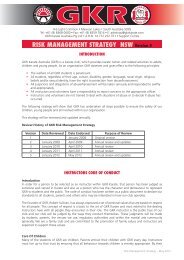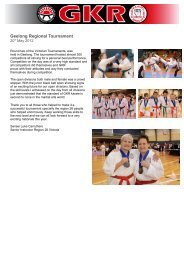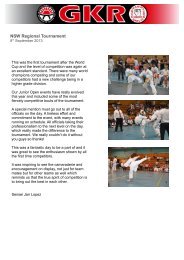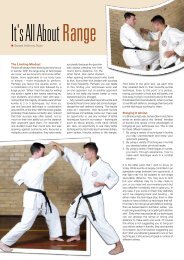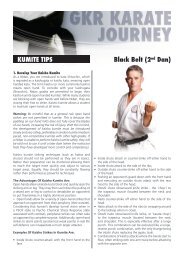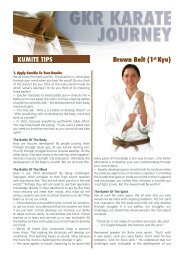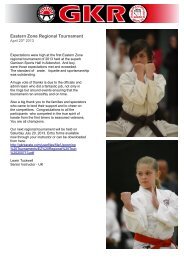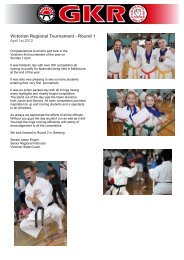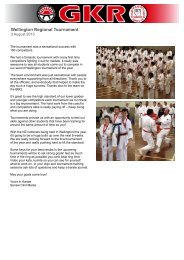Training1_stance 06_.. - GKR Karate
Training1_stance 06_.. - GKR Karate
Training1_stance 06_.. - GKR Karate
Create successful ePaper yourself
Turn your PDF publications into a flip-book with our unique Google optimized e-Paper software.
Enhanceyour<strong>stance</strong>and tips on• Sensei Jason WrightHipsAs a senior instructor, I have the opportunity to visit many classes. In my travels, I havebeen impressed overall with the upper body prowess many of our karate-ka have attained.However, in the pursuit of an all-embodied karate effectiveness, upper body prowess is notenough. Two other areas require attention to achieve this.1. STANCES ‹2. HIPS ‹Both areas are essential to attaining overallkarate effectiveness and both must bedeveloped in the order by which theyare numbered. For example, one cannotproperly develop hip movement if theyhave yet to establish sound <strong>stance</strong>s. Whiledeveloping both are imperative, whatis most important is the way they worktogether (the interrelation among the two).A karate-ka will never be able to use theirbody effectively to generate real poweruntil they can coordinate the two. So withall this in mind, I would like to share someideas, thoughts and philosophies that Ibelieve will make a difference and improveyour overall karate.‹STANCESStances are the foundation of our karate.It is a fact that ‘Poor <strong>stance</strong>s will alwaysequal poor karate’. Considering physics,suggests that power is generated fromthe ground up. If you cannot derive powerfrom your techniques, then the first areayou need to revise is your <strong>stance</strong>s. Youcannot achieve power without a strong,solid footing to carry the move. We allknow that a house will crumble if thefootings are not solid, and this very sameprinciple applies to almost anything, andkarate bears no exception.“Near enough should never be goodenough!”Always work to improve on your current<strong>stance</strong>. Good form will only come fromcorrect formation. This requires practiceand repetition. Most make the error byrepeating the technique 10 or 12 timesover. During the first few repetitions,tiny errors arise, but each time, a slightimprovement or correction is madeand generally the last few are spot on.However, this is hardly sufficient! Why?Because it may help you during yourtraining session, but when you go awayand return a day or more later, your bodywill have forgotten. Once more you willrequire 7-8 repetitions before it is spot on.In a real situation, we forego the luxury ofnumerous attempts. It must be first timeperfect! Thus, the key is to repeat it overand over. You may get it perfect by numberten, but it cannot stop there. Repetitionis not about repeating it until you getit perfect. It is about repeating it onceyou have it perfect! Until you feel itin your bones. Until the only way youknow how to do it is perfect. It is notmerely a quest to attain perfection, but aquest to only know perfection.“You Only Fool Yourself”So often, <strong>stance</strong>s suffer as a studentgrows weary. They compromise the onething that must never be compromised.They may maintain all the effort in theirupper body, but this will not suffice, andthe power output will be scarred. Youcan fool yourself into believing you arestill being effective, but a real life situationwould tell you otherwise. Not only would30 | SHIMBUN
your strikes be less powerful, but youwould be easily moved off balance. If weconcur that karate trains us for real life,then we must adhere to the philosophythat during class, we can ill-afford tocompromise our <strong>stance</strong>s.“Strong Legs and Strong Mind”All this may take time. By maintainingour <strong>stance</strong>, we develop leg strength,and the stronger our legs are the betterour <strong>stance</strong> will be. This process can behastened by extra curricular activities suchas leg strengthening exercises at a gymor at home (squats, leg press, running,swimming with flippers, skipping etc).These will help condition your legs to beable to hold <strong>stance</strong>s longer and movefaster. They also condition your mind asthe focus on hurting legs too often takesaway the quality of the technique.“Everything Working Together”With <strong>stance</strong>s, take note of the little things,such as foot positioning, knees, legs andof course, your hips (my next topic). Onlywhen all the pieces come together do weget a solid <strong>stance</strong>. Just try making a sound<strong>stance</strong> when one foot is off, or the widthis incorrect. You must pay attention to allthe small details. If your body is in conflict,then you cannot perform your <strong>stance</strong> inits true form. Getting your feet, legs, andupper body all in the correct position isimportant to practise strong <strong>stance</strong>s.“Position and Transition”When it comes to <strong>stance</strong>s, there aretwo elements. Firstly, we must get goodat ‘Position’. This implies moving into achosen <strong>stance</strong> quickly, then holding it (theway we practise <strong>stance</strong>s in basics). Oncewe have developed this, we must thenlearn ‘Transition’. This implies moving fromone <strong>stance</strong> to another in smooth, quickmovements (the way we practise <strong>stance</strong>sin kata). Each of these is essential for akarate-ka.“Don’t Takes Chances On Stances”– Application Of StancesWhether in your pursuit of Position orTransition, you cannot afford to take achance on <strong>stance</strong>s by giving them a lowpriority on your karate ability checklist. Asdiscussed earlier, your <strong>stance</strong>s are the areayou can never compromise. So look at theapplication of <strong>stance</strong>s.Position: If attacked, our ability to get intoa strong <strong>stance</strong> within milliseconds, andthen hold it against an assailant’s pressure(whether blows or grabbing), long enoughto deliver a defining blow is imperativeto our chance of success. The personwho has not developed an ability to landimmediately in correct <strong>stance</strong> may findthemselves tackled to the ground beforethey can throw a strike, or off balance somuch they are unable to throw an effectivestrike.Transition: Let us hypothesise that thesituation endures more than one blow,or is against multiple assailants. Noweverything changes. Our ability to moveinto one strong <strong>stance</strong> to deliver a definingblow, and then move quickly to anotherstrong <strong>stance</strong> to either deliver anotherdefining blow (or perhaps avoid one), willbe imperative to our chances of success.The person who has not developedtransition may find they can dispose of thefirst assailant quickly, but are then quicklyoverwhelmed by the second or thirdassailant.I will be the first to admit that these arebleak situations to envisage. However,could it not be our lack of appreciation,an ignorance into the role <strong>stance</strong>s playin a karate-ka’s overall effectiveness thatcauses them to take the near enough isgood enough approach?‹HIPSI have in my time, seen a number ofstudents who possess good <strong>stance</strong>s, butare yet to develop proper hip movement.Blame is often cast towards a lack offlexibility, and, while in many cases theirflexibility is a burden, were they to spendquality time on this area they would surelymake measurable progress. Therefore, Ibelieve the true culprit (once again) to be alack of understanding of the importance ofhip movement. That said, the first area onemust develop when it comes to ‘Hips’ istheir appreciation.Hip Appreciation 101Note, in the earlier self-defence examples, Iused the term ‘defining blow’. It is the goalof any karate-ka, if attacked, that they dealwith a situation as quickly as possible. Thiscan be achieved by two means:A) From within a strong <strong>stance</strong>, direct allattacks to vulnerable areas (groin,throat, eyes, solar plexus etc).B) From within a strong <strong>stance</strong>, developthe proper use of the hips to helptransfer body weight and generatepower.As a means of generating power, tocoincide with the development of sound<strong>stance</strong>s, effective hip movement isquintessential. Every karate strike (be it‹ ‹ ‹ ‹a hand or foot technique) must involveyour hips. Metaphorically speaking, if ourhands and feet are bullets, then our hipswould be a trigger. And, as with any gun,you cannot fire a bullet without first pullingthe trigger. Without hips, you are literallystriking with no more than a limb (an armor leg). The inclusion of the hips carriesforward your body weight into the strike.They also provide torque, extra forcedeveloped through rotation or twisting.The use of the hips can virtually doublethe effectiveness of any strike. Evidence ofthis can be seen by hitting into a punchingbag. Furthermore, just watch any tennisplayer use their hips when they want someextra sting on their forehand. Or a baseballplayer trying to hit a home run. Even afootballer (soccer) trying to nail a ball intothe corner of the net. In each case, you willsee the whipping of the hips millisecondsprior to the strike.Position And TransitionFirst and foremost – as with <strong>stance</strong>s– it is required with both ‘Position’ and‘Transition’.To develop ‘Position’, standing in longforward <strong>stance</strong> in front of a mirror forexample, and moving the hips squarethen back 45 degrees repeatedly will dowonders in a matter of weeks. Put yourhands on your hips, keep your elbows out,and let them move with the hips. This willgive you a good gauge as to the extentof your movement. Whilst looking in themirror, be sure your <strong>stance</strong> is not beingcompromised while moving your hips. Afteryou have repeated this numerous times,change legs and start again.‘Transition’ refers to our ability to moveinto a <strong>stance</strong> with the use of our hips.This is merely an extension of the previousSHIMBUN | 31
‹exercise. As opposed to standing in thesame <strong>stance</strong>, you will be moving forwardor backwards into <strong>stance</strong>. In practice,keep the hip movement simple, short andsharp. Avoid winding up your hips earlyin the movement. Keep them still until thelast split second then lock them into place(square or 45 degrees) simultaneouslywith the <strong>stance</strong>. It is wise to practise thiswithout strikes or blocks, and add theselater.What Makes It Work For YouThere are many exercises to developyour hips. The great part is that hipdevelopment requires little room, aslong as you have space for long forward<strong>stance</strong>. The deciding factor as to whetheryou practise and develop this, or largelyignore it comes down to your own level ofdiscipline to work at it regularly. With selfdiscipline,the results will be amazing!Hips In Heiko-datchi<strong>Karate</strong> is about generating maximumA predominant error with hips is their power from your entire body. Withoutoveruse in heiko-datchi (ready <strong>stance</strong>). your hips leading the way you will not bePerhaps to make up for a minimal hip able to achieve this objective, nor developmovement in <strong>stance</strong>s, while practising your karate to its fullest potential. Don’tbasics in heiko-datchi, students often simply dismiss these points by saying, “Iwind their hips up just prior to throwing already use my hips”, because regardlessthe technique and then have an enormous of grade, you can always get better andhip movement whilst executing the strike. develop more than you have today. <strong>Karate</strong>This forms a bad habit for kata and is a never ending journey or as we say inkumite. Firstly due to that fact that an <strong>GKR</strong> “A way of life”.overuse of hips detracts power out of a€technique by throwing the body’s weightand force into directions other than straightahead. Secondly, it develops a habit oftelegraphing (in essence, giving youropponent foreknowledge that a strike iscoming). The notion behind hip movementshould be towards effectiveness, andnever for aesthetic (appearance) reasons.shines againat the NAS NATIONALS32 | SHIMBUNJust six weeks after the 2005 <strong>GKR</strong>World Cup, and <strong>GKR</strong> Australia’s topstudents were competing in anothermajor tournament. Over 600 competitors,representing every state and every majormartial art style converged on the GoldCoast for the N.A.S National Titles. Of thefield, a little over 120 competitors wore the<strong>GKR</strong> badge, and wore it proudly, at this,Australia’s largest and most prestigiousmixed martial art tournament circuit.8 rings ran non-stop over two days with<strong>GKR</strong> taking out numerous National Titles,proving once again that a style based onsimplicity is highly effective. With too manynames to mention, <strong>GKR</strong> faired well acrossevery event entered.Among those who succeeded were anumber in the Black Belt Open Divisions.Lyndal McNamara won the FemaleLightweight Division and runner up in theChampion of Champions.<strong>GKR</strong> took out a clean sweep of the Men’sMiddleweight Division with Anthony Joywinning his second Middleweight title ina row, with Craig Lennox and Paul Adelepicking up 2nd and 3rd respectively.Anthony also came runner up in theChampion of Champions division.Erkan Saygili won his way to two finalswinning the Men’s Heavyweight Title andcoming runner up in the Open Weight.Joanne Salmon picked up 2nd place in theFemale Heavyweight Division.Claudine Chicheportiche became <strong>GKR</strong>’sfirst female to win a National Title for theWomen’s Open Continuous Sparring.The weekend belonged to BenCunningham however who won theMen’s Open Weight Division in a nail biteragainst team-mate Erkan Saygili. Benthen went onto win his second Championof Champions Title, making him the firstmale to do so. He also placed runner-upin Open Kata, and 3rd place in the Men’sLightweight Division.Congratulations to all those whorepresented <strong>GKR</strong>. Sensei’s NabilFanous and Mark Case who werepresent both expressed how proudthey were of the etiquette, discipline,sportsmanship and competitivenessamongst all of you.



